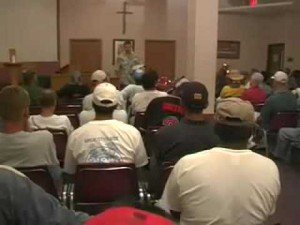When I came to Kansas City in 1990 and my focus turned from direct involvement to training people to become addition counselors and helping them to manage more effective programs. However, I’ve stayed in touch with the “hands on” dimension of recovery work by volunteering at local rescue missions and for other organizations that help addicts and their families. Conducting chapel services for program participants and interacting with them is something I always look forward to doing.

One local mission, the Kansas City Rescue Mission, where Joe Colaizzi serves as executive director, is an example of a rescue mission recovery program that is doing a lot of things right. Their recent follow-up efforts reveal that for three years running, 70% of their graduates are still sober for year or more after leaving the mission. This is a very good rate of success. So, what are some of the things they are doing to promote such success?
A. They have a well-organized program – A “program” is best defined as “the planned, organized, and systematic delivery of services – using both internal and external resources– with the goal of meeting the unique needs of each individual.” The key words are “planned” and “systemic.” This means that everyone – staff, administration, volunteers, and clients – are all “reading off the same page.” At the Kansas City Rescue Mission, everyone knows what is expected – what staff members expect of residents and what residents can expect of staff members. Their daily schedule is clear and events begin on time. Their rules, which kept to a minimum, are well established and upheld equitably. Since sobriety is rule number one, any use of intoxicating substance leads to immediate dismissal with possible readmission after a predetermined time, 30 days in most cases.
Being well organized means minimizing external distractions and “game-playing” and keeps people focused on working on themselves. The Kansas City Rescue Mission has achieved something very special – the men in the program are so committed to recovery that it is “self-regulating.” As a result, people who do not want to recover don’t stay. And, the staff members are spending most of their time helping people instead of enforcing rules.
B. They are not “re-inventing the wheel” – To assist our member missions, at IUGM we published a resource in 1993 called A Guide to Effective Rescue Mission Recovery Programs. The principles contained in this 12 tape staff training tool are well established and proven to work in the treatment and rescue mission recovery field.
The Kansas City Rescue Mission has fully implemented our suggestions. They use regularly updated written client recovery plans. Their classes include relapse prevention and other addiction-specific topics, along with Biblical. And, they have well-defined phases through which participants progress. These phases are not simply time-based, but are instead based on residents attaining specific recovery-oriented goals, as contained in their written recovery plans, if they are to move into higher stages of the program.
Program people are motivated by instruction and activities that “get right down to where they live”. If we are dealing with the real, pressing areas of need in their lives, they will be more committed to the process. This is how we show them we understand them and are, ourselves, committed to helping them to become all God wants them to be.
C. They help program participants to recognize their progress and celebrate with them over it – One of the most important duties of mission staff members is to maintain an environment that encourages people to make changes in their lives. A big part of this is rewarding people for making good choices that lead in a godly direction. I saw this in practice during a recent program chapel service at the Kansas City Rescue Mission.
Every month they recognize those who have some months of “clean time” by giving out AV chips during their chapel services. And, those who are moving to a higher phase in their programs receive a printed certificate to recognize and acknowledge their progress. Program participants are always more motivated when we give them “benchmarks” by which their progress can be measured. They need to feel they are getting somewhere and not just biding their time at the mission. Developing written recovery plans with regular reviews and updates will accomplish this. And, just as KCRM does, we need to reward them for attaining them.
More than anywhere on earth, rescue missions ought to be filled with the type of joy and celebration we see in the father of the prodigal son. He exalted over his son who was lost and now is found. A simple little plastic coin or computer-printed certificate given to them in front of their peers may not be a fatted calf or golden ring. But, they can mean a lot to someone who has been experiencing nothing but failure for years on end. Let’s be sure to find creative ways to recognize and celebrate even small changes and right decisions.
(Most of this article originally appeared in Rescue Magazine January/February 1997 AGRM)
